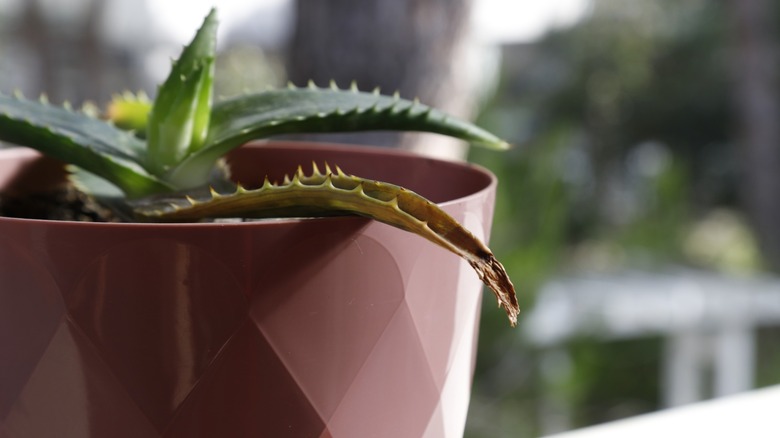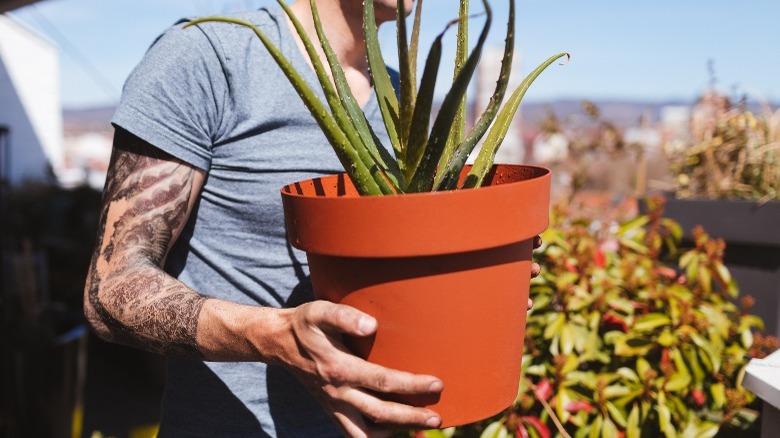Breathe New Life Into Your Rotted Aloe Vera Plant With These Essential Tips
The aloe vera plant is popular among homeowners and gardeners for its hardiness and low-maintenance qualities. But don't let its easy-to-care-for nature deceive you. It still requires proper attention to thrive, and there are many common aloe issues to keep an eye on. For instance, it's particularly sensitive to overwatering, the most common cause of root rot in aloe vera plants. If your aloe vera has rotted or doesn't look as healthy and vibrant as it once did, you can still remove the rotted parts. Detecting root rot in your aloe vera can be tricky, but one clear indicator is leaf discoloration. Typically, aloe vera plants boast fleshy, vibrant green leaves.
Your aloe vera plant's yellow leaves are trying to tell you it's already suffering from root rot. This condition hampers the plant's ability to absorb water and nutrients, leading to drooping, twisted, wilting, or dried-out aloe vera plant leaves that might fall off at the slightest touch. You may also notice the plant becoming slimy and mushy or detect a foul smell from the plant or its soil. To confirm root rot, loosen the soil around the roots and check the roots themselves. Healthy aloe vera roots are firm and can be yellow, brown, or orange. In contrast, rotting roots appear slimy and mushy and are typically black or dark brown. Fortunately, aloe vera plants are pretty tough to kill — you can still revive your rotted aloe vera plant with a few simple steps.
How to save your rotted aloe vera plant
First, remove the plant from its pot to treat your aloe vera for root rot. Use sterilized scissors or a knife to cut away all damaged roots and any infected leaves or plant parts. It's crucial to sterilize your tool between each cut to avoid spreading the infection. If only the leaves are rotten and the root system is healthy, remove the rotting parts, similar to how YouTuber gardener The Aloe Vera Garden managed his aloe vera with rotting leaves. If the entire root ball is infected, cut just above the infected area and peel off the rotted parts. You can then sterilize the plant roots with undiluted 3% hydrogen peroxide, similar to what TikToker @tannertheplanter did.
After pruning, let the plant air dry in a dry place for a few days until the cut areas become callused and hard, which helps make it more resistant to pathogens and infections. Then, plant the aloe in a smaller pot filled with a commercial cactus or succulent mix. If that option is unavailable, mix regular potting soil with perlite, coarse sand, or more perlite to ensure good drainage. According to @tannertheplanter, using a smaller pot helps prevent the remaining roots from overworking. Once the plant has developed a robust root system, it can be moved to a larger pot. For a successful recovery, water the plant sparingly and avoid direct harsh sunlight.
How to prevent root rot in your aloe vera
The best way to prevent root rot is to ensure your aloe vera plant is given the right conditions to thrive. This involves avoiding overwatering your plant and using a pot with good drainage. Use a soak-and-dry method when watering them. Deeply and thoroughly water the plant, with water flowing freely from the drainage holes. You should wait for the soil to dry out completely before watering it again. Like other succulents, your plant also prefers a well-draining soil similar to its native desert environment.
It's also important that your plant gets the right amount of light — aim for six to eight hours of bright, indirect sunlight. Be sure not to expose it to harsh, direct sunlight since it may cause sunburn to its leaves. When selecting a pot, choose one with good drainage and materials like clay or terracotta over non-breathable options like plastic. These pots are made of porous materials that help keep the soil dry, which is beneficial for aloe vera. Additionally, since aloe vera roots tend to grow horizontally, it's best to use pots that are wider rather than deeper. Choose a pot about 2 inches wider than the plant to provide ample space for root growth.

